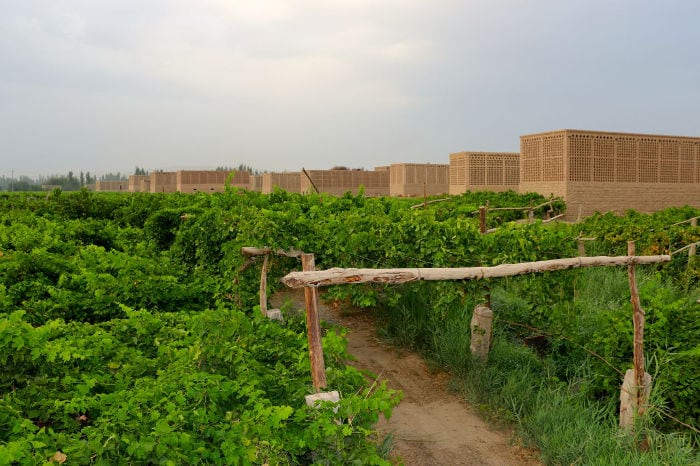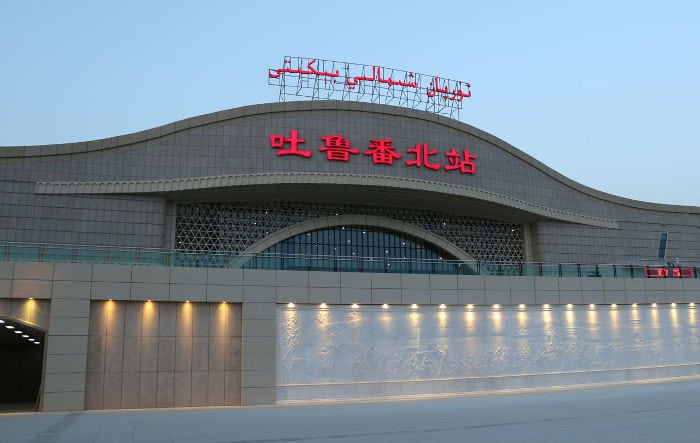
This article was written by Josh Summers, the founder of FarWestChina.
I remember years ago taking a trip to Turpan, a quiet but once important stop on the ancient Silk Road. I woke up early in the morning to catch a bus from the Xinjiang capital of Urumqi where I spent over three hours sitting in a chair whose padding had long ago been worn down to nothing.
It’s funny to think about that now as I write this from the comfort of my first-class seat on Xinjiang’s new high speed train. The grueling three-hour bus ride is now reduced to less than an hour on the train, and the cost of my ticket was the same.
You see, here in Xinjiang, China’s largest administrative region by land area, the idea of a “day trip” is almost laughable. Unless you’re willing to fly everywhere you want to go, most travelers have to budget whole days for transit between different parts of Xinjiang.
Now that the new high-speed train has begun operational, however, a day trip to Turpan is not only possible, it’s actually quite enjoyable.

Why Visit Turpan?
Even after living in this part of the world for more than five years, Turpan remains one of my favorite places to explore. Not only does the city retain the beautiful Uyghur culture that is slowly disappearing, it also boasts a tangible history as part of the Silk Road that is absolutely fascinating.
Take, for instance, the Jiaohe Ancient City Ruins, located just a few kilometers to the west of Turpan. Once a thriving capital of the region, it was abandoned somewhere around the 13th century after a Mongol invasion.
 Jiaohe Ancient City Ruins
Jiaohe Ancient City Ruins
The city was never completely destroyed, however, and the city layout remains largely intact allowing travelers to walk the ancient main street, explore the city temples and imagine what it would have been like to live here centuries ago.
Or perhaps you’re drawn more to engineering marvels as opposed to historical ruins. If that’s the case you can travel just a couple kilometers northeast to experience the karez, an underground system by which snowmelt is transported through the blazing hot Turpan Depression to water the crops and vineyards around the city.
 The karez
The karez
Long before heavy machinery or precision instruments had been invented, the ancient Uyghur people figured out a way to dig thousands upon thousands of underground karez that kept their city watered and alive.
Finally, if architecture is your thing you can head to the opposite side of Turpan where you’ll find the Emin Minaret situated next to sprawling grape vineyards. Having been built in 1778, Emin doesn’t have nearly the history that the Jiaohe Ancient City does, but the building is in much better condition making the beautiful Uyghur architecture easily visible.
 Emin Minaret
Emin Minaret
It used to be that visitors could climb the spiral staircase to the top of the minaret for some spectacular views of Turpan but, thanks to safety regulations, we now have to be content to appreciate the minaret from the outside only.
It’s not a terrible view, though. The brickwork on the Emin Minaret represents Uyghur architecture at its finest, with floral and wave designs that stretch the entire 37 meters in height.
Turpan Travel Tips
There are numerous other excellent sites to visit in Turpan including Tuyoq village, the Gaochang ruins, the Flaming Mountains, the Beziklik Caves and more, but most of these are further outside the city and require more than just one day to see.
Although Turpan has plenty to offer most any month of the year, the best time to visit is July through September when grape season is in full swing. Grapes hang everywhere and are so abundant they practically hand them out for free on the street.
Finally, as I mentioned earlier the high-speed train is now the transportation of choice if you’re headed from Urumqi. The train station is a bit outside the city but it’s easy to access by taxi (20 minutes; 25 Yuan) or you can even take the 202 bus all the way to the station (1 hour; 1 Yuan).
 Turpan train station
Turpan train station
For even more detailed information on visiting Turpan, including the best hotels to stay at or detailed descriptions of each tourist destination, take a moment to check out FarWestChina’s Turpan City Guide.
Turpan is a travel gem along the ancient Silk Road and a place you won’t regret taking the time to visit. With a perfect mix of culture, history and a small-town feel, you’ll leave with plenty of great photos and stories to tell!
p.s. Click here if you want to read our interview with Josh.
Photo Credits: Photos by Josh Summers



